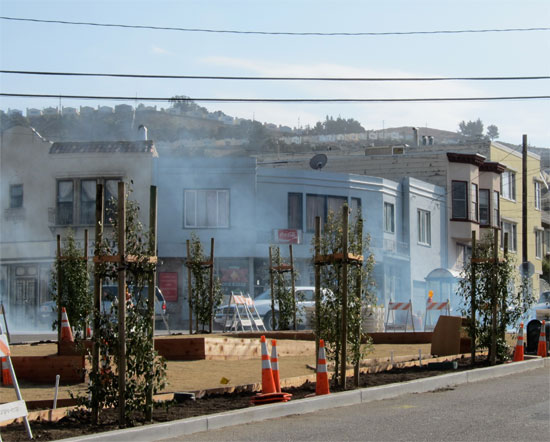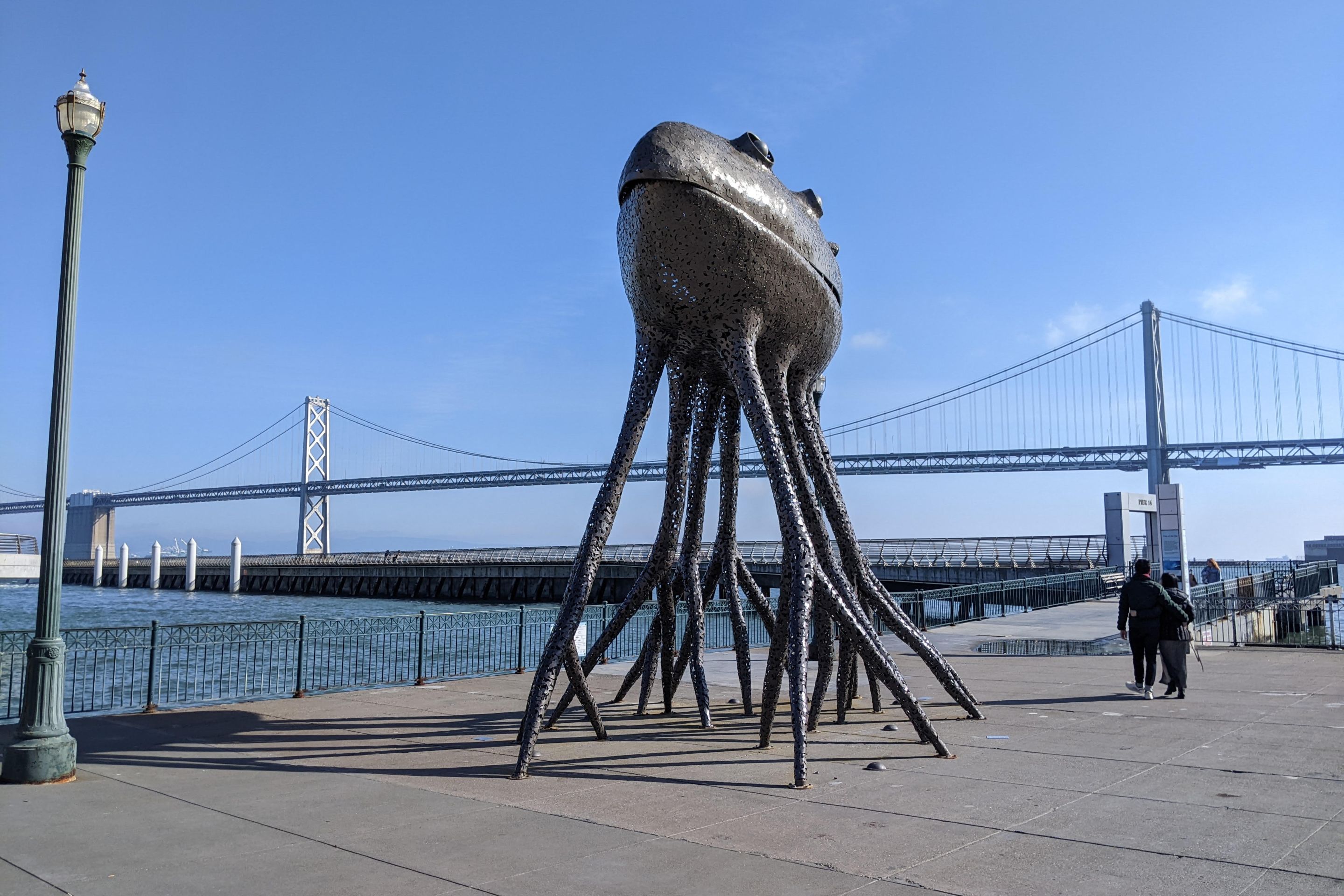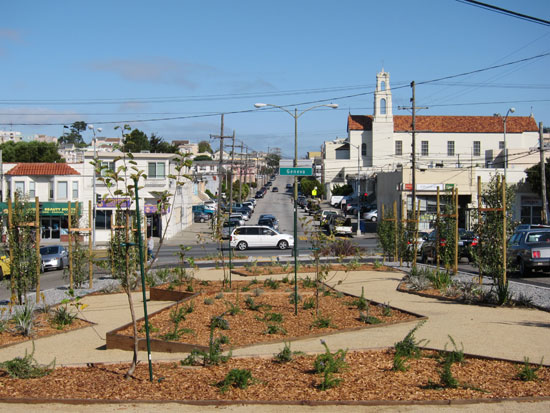
Community groups, city staff and elected officials celebrated the opening of the final Pavement to Parks plaza this weekend, a new 7,500 square foot space that months before was a wide asphalt expanse notorious for speeding traffic and more than a few drivers doing donuts amid smoking tires and revved engines.
City Attorney Dennis Herrera hailed Naples Green, a square in the Excelsior on Naples Street between Geneva Avenue and Rolph Street, as a "testament about what happens when community and government work together."
Herrera invoked the history of the plaza, which in 1915 was turned into a temporary park to celebrate the Pan-Pacific Exposition and herald San Francisco's recovery from the 1906 earthquake. "This park is a testament also to what it means for San Francisco values and community history," said Herrera. "I can't think of anything better to commemorate what San Francisco is all about--a phoenix, a city rising and being everything that it can be--than the reestablishment of this park and bringing green space to this wonderful neighborhood."
For years a group of merchants had been working through the Outer Mission Merchants and Residents Association (OMMRA) to improve the former slab of asphalt, first succeeding to get traffic calming and medians to slow speeds and reduce stunting, then finally convincing District 11 Supervisor John Avalos to cobble funding together through the city budget process and separate agency coffers. In all, the project cost $150,000, much of it coming from the San Francisco Municipal Transportation Agency (SFMTA), which controls the streets and runs Muni, the San Francicco Public Utilities Commission, the Department of Public Works (SFDPW) and a $10,000 grant from the Wells Fargo Foundation.
Avalos applauded the community and OMMRA for their steadfast commitment to transforming the space, referring to the frequent donuts and reckless driving that occurred there previously. "This is a community that has seen too much grass, too much greenery, paved over, so to reverse that in such a magnificent way, in such a large way is really great to see," he said. "We know we're going to have more people using the space, that will be an inhibition to the kinds of activities that were going on here before."
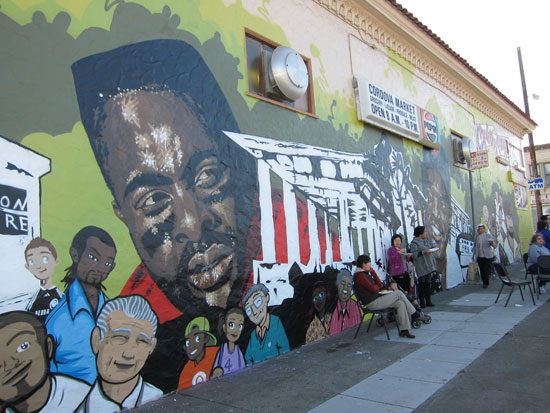
In addition to a plaza with trees and seating, which was not installed at the press conference but should be this week, the community groups and merchants were proud of a giant new mural painted on the side of the Cordova Market facing Naples Green. The mural depicts numerous sports heroes, with two large pictures of Jerry Rice of the San Francisco 49ers and Willy Mays of the San Francisco Giants, as well as the current World Series Champion Giants team, replete with fearsome beards.
Aslam Ali, the owner of Cordova Market who made his wall available for the mural, was shocked by how quickly muralist Max Erhrman and the San Francisco Clean City Coalition had transformed his blank wall into a beautiful piece of art. "The people who did this mural, unbelievable. I cannot believe this was done in four or five days," said Ali, who recently purchased the store with his son. "We're trying to clean up this neighborhood and this mural is part of it. We're going to turn this store around and serve the neighborhood."
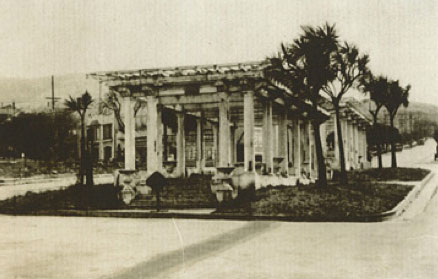
Most of the organizing for the project came from OMMRA, which formed 13 years ago to coordinate improvements to the neighborhood. In the process, OMRRA was happy to discover the unique history of the space. OMMRA's Steve Currier noted the similarity to the first Naples Piazza, which was also built as a temporary installation, though he was proud they had secured enough funding to make it semi-permanent. The community will likely continue seeking grants to add to the plaza in the future.
"It was said this week that it took the San Francisco Giants 52 years to bring the World Series to San Francisco. It's taken us 90 years to get this park back," said Currier. After joking that DPW Director Ed Reiskin should be appointed interim mayor once Gavin Newsom moves to Sacramento in January, Curier thanked the merchants and the community for embracing the project. "This was a collaborative effort with our community, our merchants. There was tremendous support from our merchants," said Courier.
In addition to reflecting on the history of the space, Courrier was excited for the calming effect the park would have on the neighborhood. "We wanted a quiet space. To put in this space and when the plants and trees get bigger, it will quiet the neighborhood."
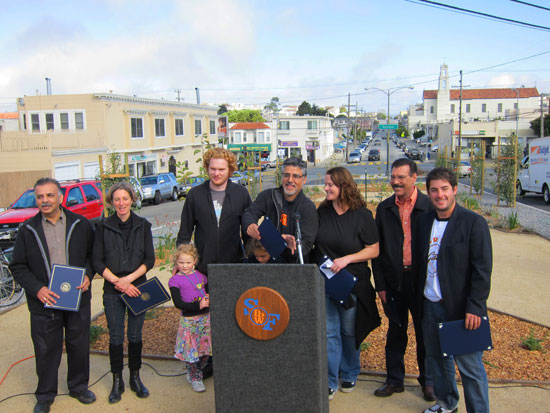
Jane Martin, who also designed the San Jose/Guerrero Pavement to Parks Plaza, contributed to the design of the space. Martin said the orientation of the space, essentially a long rectangle with a slight grade and streets around it, made it difficult to create programmed activities for kids, which she had initially hoped to do.
"I tried to make it like a maze, so that there is a lot of exploring, some of the sectional property of the street, try to maintain that rather than creating a flat space," explained Martin, who said the plaza would be a sight to behold in a year to eighteen months, when the bushes and trees had grown. "The angles are to get rid of the street grid. It's to give you a place to meander."
Though the Naples Green project marks the final official Pavement to Parks endeavor, DPW's Reiskin said the agency would continue to look for more projects like this and seek innovative ways to fund them. "Twenty five percent of the area of San Francisco is covered with our public rights of way, which means mostly asphalt and concrete and it was largely built just to convey vehicles, for people to pass through. What we're here today seeing is just one more transformation of public space, giving it back to the community. It's part of a transformation of our public realm."
The DPW and the San Francisco Planning Department will focus in the coming months primarily on the implementation of the more than 40 parklet applications they received in response to their request for proposals in September. Reiskin credited Mayor Newsom for institutionalizing the commitment to reclaiming under-utilized streetspace to create open space, and vowed the city would continue after Newsom moves on.
"We still have a lot of under-utilized hardscape in the city that was built for cars that we want to give back to people," said Reiskin. "We don't have funds available for a lot of them, but a lot of these started without funds and once you have a good idea and once you have a strong community behind it, you've got a plan, sometimes the money comes."
